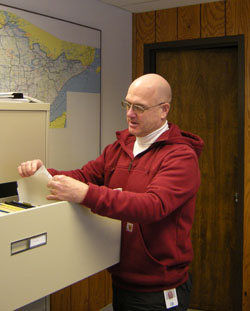By Lisa Yang

Bob Wryk, District 1 Maintenance superintendent, is responsible for maintaining all state highways in District 1. Photo by Dave Ollila |
As District 1 Maintenance superintendent, Bob Wryk is always planning a season ahead to make sure the public can travel as safe as possible, whether it’s winter or summer.
Wryk is responsible for all state highways in District 1. The maintenance crews under his direction take care of everything they can on the roads, including filling potholes, installing guardrails, managing snow and ice removal, sweeping roads, trimming trees and removing debris.
Wryk began his Mn/DOT career in 1979 as a Maintenance employee at Metro District’s Maple Grove Truck Station. He then became intermittent supervisor at the Plymouth Truck Station before being promoted to Metro District nighttime supervisor, the department’s first permanent full-time night supervisor. Wryk’s next stop brought him to the western edge of Metro District, where he worked as supervisor of the Camden Truck Station until he was promoted to Metro District superintendent in 1996. Wryk then headed north to District 2-Bemidji before arriving at his final stop in District 1-Virginia, where he has spent the past three years. Wryk plans to retire in June.
Describe your typical workday.
It starts at 4:30 in the morning. I jump on the computer by 6 a.m., check the weather and see what’s going to happen that day and what will happen that night. Then, I meet with the six supervisors who I manage and who direct the maintenance crews. We discuss what their agenda is for the day and when they plan to do certain tasks.
Most of my interactions are with those supervisors. I also receive assistance from two of my employees.
I have meetings almost every day in Duluth, Virginia, International Falls, St. Paul, St. Cloud and wherever I’m needed.
What challenges do you face in your job?
One of my challenges is personnel issues. I personally like to go out to the truck stations if there are issues that my supervisors need help with. Since I’m the only superintendent in District 1, I do a lot of traveling to get to the truck stations or to different offices.
I stay in touch with Human Resources to remedy maintenance personnel issues that occur all around the district, including incidents on the road or injuries on the job.
Our people are working out there to make sure that it’s safe for the public to travel and they do a good job. I want to make sure that our people are safe while working too.
Do you have any success stories you would like to share?
We came up with a plan to put together a district guardrail crew that would go to different areas and repair guardrail. It actually happened and the guardrail crew performed excellent. We had the right people, all the materials—we got a lot done and it was great to see something work that we came up with.
Do you have any goals you want to achieve before retiring in June?
I want to make sure the summer work plan will be good; there’s always something that should be done differently to make things a little better—a little faster. I want to make sure the person taking my job after I leave will have good notes about what should happen, like a better way to split shifts for better coverage, improve bridge cleaning to make it safer for motorcycles, balance the budget and rent or not rent certain equipment.
I also want to be able to say goodbye to everybody. I’ll miss the people. My experience here has been excellent.
Do you or a co-worker have an interesting job to share with readers? Click here to send us your ideas, and we’ll contact you for more information.
Recent employee profiles:
|



